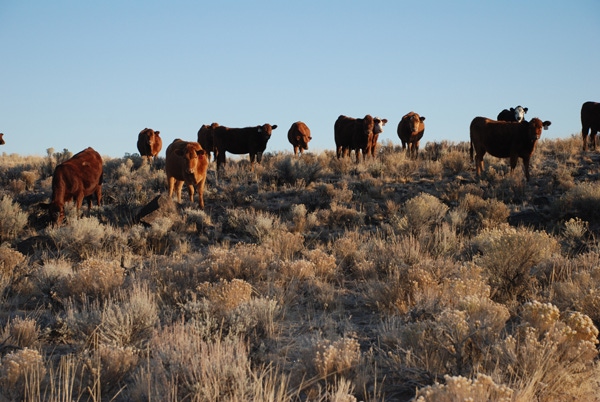Meet the beef cow: AKA "The Great Upcycler"
Beef producers have a good news story to tell; cattle efficiently convert poor rangeland to pounds of protein.
February 21, 2019

Changing consumer minds about sustainable beef production can be a chore. It’s even more difficult when a vegan presidential candidate spouts that raising cattle ruins the planet. Such nonsense amplifies the importance of research by Emily Andreini.
Her research, conducted as part of her work to earn a Ph.D. in animal biology at the University of California-Davis, illustrates how cattle “upcycle” low-quality forage into high-quality protein needed in the human diet.
What is upcycling?
“Upcycling is known as the process of reusing old or discarded materials and turning them into a product of higher value or quality,” says Andreini, whose research is partially funded by the Beef Checkoff. “It’s the popular concept to reduce, reuse and recycle to create something of higher quality without sending the item to the landfill.”
While the popular concept of upcycling often deals with gadgets and widgets, cattle play an important role, too. Regardless of popular trends and social media fads, Andreini says cattle have been upcycling long before society adopted use of the term. “In the U.S., 90% of the feed consumed throughout the lifetime of grain-fed cattle is human-inedible,” she says.
“Cattle upcycle low-quality, human inedible feeds that humans or some other animals cannot consume. They convert them into a high-quality, high-protein product in the form of beef.”
Andreini was raised on a cattle and sheep operation north of Sacramento, Calif. She points out that vegetation on about 800 million acres, or 35% of the U.S., is inadequate for human consumption. But many of these acres are good for grazing cattle.
Just the facts, ma’am
Andreini’s research findings are part of NCBA’s program series to address “tough questions about beef sustainability.” As a contractor for the Beef Checkoff program, NCBA helps get such “beef facts” out through social media and other avenues.
Those “beef facts” need to be known to counter anti-beef comments like those from U.S. Sen. Cory Booker, (D-New Jersey), who has many followers. When he announced his candidacy for president in mid-February, Booker said, “The tragic reality is this planet simply can’t sustain billions of people consuming industrially produced animal agriculture because of the environmental impact.
“It’s just not possible, as China, as Africa move toward consuming meat the same way America does because we just don’t have enough land.”
FILL YOUR TOOLBOX: Upcycler Fact Sheet from beefresearch.org
The proposed Green New Deal, which could heavily restrict beef production, also attacks animal agricultural production. Thankfully, Andreini’s efforts are helping set the record straight.
“We’re working to get our message out to consumers,” she says. “We have a short fact sheet that is usable for consumers. They don't want to read a 10-page scientific article.
“When we in agriculture talk to consumers, we can make a connection. Most consumers trust what ranchers or farmers have to say. They realize you’re a consumer, too. You grow beef and consume beef. It resonates with them.”
On a plane trip to the recent Cattle Industry Convention NCBA Trade Show in New Orleans, Andreini sat by a woman who had misconceptions about meat production.
“I talked to her about how my family produced beef,” she says. “She was open and willing to listen. It was refreshing. She felt I was a good source of information. She said, ‘when I go to the grocery store, I’m going to rethink my buying choices.’ The fact that all beef is grass-fed most of its life opened her eyes.”
Andreini points out that college students with an urban upbringing also appreciate the truth about beef production. “At UC Davis, we grad students help teach animal science classes to undergraduates hoping to get into vet school,” she says. “We have an opportunity to talk to those students and help them learn about agriculture.
“The upcycling message connects with them. They take that message home to their families. It just takes one to help change other people’s minds.”
By-products count, too
Andreini’s research also points out the many by-products of beef production. She encourages people involved in all phases of ranching, feeding and farming to talk to their family, friends and neighbors, many of whom may hear only one side of the beef production story.
“Cattle also consume by-products from biofuel and food industries, such as distillers grains from ethanol production and wheat middlings from flour milling,” she says. “Use of these by-products as cattle feed decreases the respective industry’s waste by providing an alternative use of the by-product compared to sending it to the landfill.”
“We’ve heard a lot of discussion on why we should convert to plant-based diets and move away from meats in the diet,” she says. “Hopefully this and other ‘beef facts’ programs will broaden that discussion for beef’s place in the diet. Consumers need to know that beef is an important source of protein and nutrients needed in our diets.”
Larry Stalcup is a contributing writer from Amarillo, Texas.
About the Author(s)
You May Also Like


.png?width=300&auto=webp&quality=80&disable=upscale)
